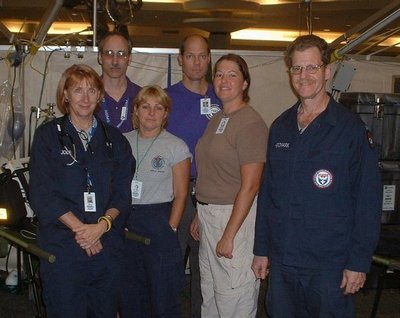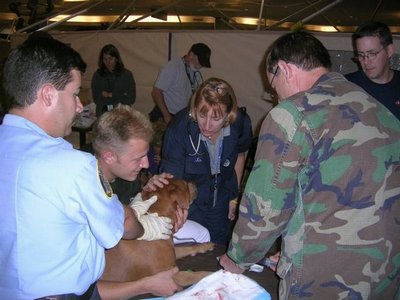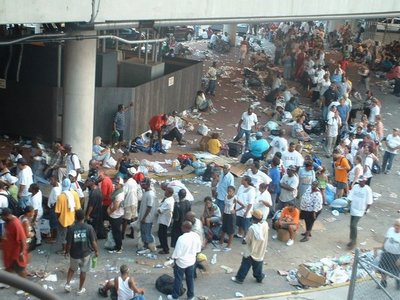September 29, 2005
UW, HMC talents respond to Hurricane Katrina
Dr. Kathleen Jobe has seen a great many crises during her years in emergency medicine at UW Medical Center and as a medical volunteer in Third World countries. But none of that compared to the scene she encountered at the New Orleans airport earlier this month as a volunteer in the aftermath of Hurricane Katrina.
“It was exhausting, heartbreaking, exhilarating, overwhelming and inspiring simultaneously,” said Jobe, one of several UW faculty and staff deployed to New Orleans as part of Disaster Medical Assistance Teams (DMAT). “It was probably the hardest thing I’ve done as a physician.”
Jobe, medical director of the Emergency Department at UWMC, an associate professor of medicine and acting head of the Division of Emergency Medicine, had flown to Houston the day before Hurricane Katrina hit the Gulf Coast.
Other DMAT members from UW included Dr. Chris Sanford, co-director of the Travel Medicine Clinic at Hall Health Primary Care Center; Charlie Valencia, pharmacist at Harborview Medical Center; Harborview nurses Steve Felton, Ellen MacDonald, Wendy Palmer and Julie Mandart; and Jay Herzmark, the group’s safety officer, who works for UW Environmental Health and Safety.
Felton drove one of the DMAT supply trucks from Seattle to New Orleans along with MacDonald. The pair, along with Valencia, has since been redeployed to the Gulf Coast to assist with the continuing medical needs in the region. Joining them from UWMC are Dr. Laura Fife, assistant professor in the Division of Emergency Medicine, and Nichole Shounder, nurse in the emergency department. Joining them is nurse Cheryl Stromberg of Harborview.
After the hurricane hit, the team drove first to the Superdome in New Orleans, Jobe said.
“It was a bit scary — the floodwaters were rising at that time, and we were in vehicles with water up to the running boards,” she said.
But on arrival at the Superdome, the team was turned around and sent to Baton Rouge. Two other DMATs stayed on at the Superdome, while the Washington team and others finally drove by police escort in a convoy to the Louis Armstrong New Orleans Airport, arriving in the early morning hours of Aug. 31.
The teams set up on a concourse with three treatment tents — green, yellow or red, depending on the severity of injuries and urgency of care.
“We had no potable water the whole time and no power for the first 36 hours, only some emergency power and generator power to run lights in our tents,” Valencia said. “The temperatures inside were easily 95 to 100 degrees, with 95 percent humidity.”
Patients started arriving in small numbers initially, but within hours they were coming in by the hundreds via helicopter, ambulance, and buses. Helicopters were landing three and four at a time with patients over the next three days, as the UW volunteers slept only a few hours at a time on a baggage carrousel turned into makeshift beds.
“The pictures you saw of patients lying in the baggage claim at the airport were real. We had too many sick patients, and too few medical personnel to care for many patients in the way they deserved,” Jobe said.
There were three teams at the airport totaling 105 medical and support personnel, but in five days the teams treated and air evacuated more than 2,700 patients. Additional teams began arriving within 36 hours to help with the huge load of patients.
Jobe worked in the red tent, dealing with the most critically ill patients, including a 12-day-old baby and many chronically ill whose conditions had deteriorated. Sanford worked in the yellow tent, tending to many infected wounds inflicted by the hurricane and the subsequent flooding.
“Our job was to quickly assess these patients and get them out of there to where they needed to be. The magnitude of the needs was overwhelming,” Jobe said, “But what struck me was the gratitude of the patients. Here most had lost everything to the hurricane, and they were thanking us.”
One of the stranger moments for Jobe came when at one point thousands of Krispy Kreme doughnuts appeared.
“We used them to feed patients who’d gone hungry up until then,” Jobe recalled. “I’m still amazed that we could get Krispy Kremes within 24 hours, but never could get any Hepatitis A vaccine for people who’d been in contaminated water for days.”
Valencia and three other pharmacists and one technician kept the pharmacy operating 24 hours out of a refrigerated truck, trying to keep up.
“But the pharmacy caches are very limited and designed only to treat about 50 patients per day,” he said. “We rapidly ran out of a lot of critical medications before the U.S. Air Force and the Forest Service came through for us.”
After more help arrived later in the week and power was restored, Valencia moved the pharmacy inside — behind the bar in the Legends Bar and Restaurant, and protected by security officers.
Other volunteers arrived to help with basic patient care, Jobe said.
“They were wonderful, they did whatever we asked, never complained, even when providing the most basic, unpleasant, and unglamorous patient care. Those young kids are my heroes,” she said.
Herzmark’s initial role as safety officer was to set up the 17 tons of equipment for the mission. But as a nurse by training, he was quickly called into service, helping to care for the large number of aged and chronically ill patients evacuated to the airport from New Orleans area nursing homes.
“It was overwhelming,” Herzmark said. “There was no way you could provide care for everyone in that huge room filled with people.
But I was glad I could help; it was an opportunity to do something I hadn’t done in a long time.”
Jobe has been a member of WA-1 DMAT for over 10 years, and also as a member of a private, nonprofit group, the Seattle-King Co. Disaster Team, which identifies and participates in local and international relief missions, including a yearly mission to Haiti.
Jobe and the others expressed their gratitude to those at the University who filled in for them while they were deployed in New Orleans.
“I’d like to thank my colleagues in the UWMC Emergency Department who covered for me while I was gone, and everyone at the University who supported the humanitarian efforts in the wake of Katrina, and supported our participation in disaster relief through DMAT.”





